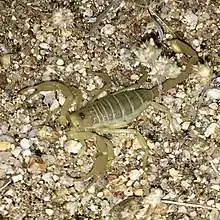| Dune scorpion | |
|---|---|
 | |
| Scientific classification | |
| Domain: | Eukaryota |
| Kingdom: | Animalia |
| Phylum: | Arthropoda |
| Subphylum: | Chelicerata |
| Class: | Arachnida |
| Order: | Scorpiones |
| Family: | Vaejovidae |
| Genus: | Smeringurus |
| Species: | S. mesaensis |
| Binomial name | |
| Smeringurus mesaensis (Stahnke, 1957) | |
Smeringurus mesaensis, also known as the dune scorpion or giant sand scorpion, is a species of scorpion in the family Vaejovidae.[1] It is common in the deserts of the southwestern United States.[2]
Description
The dune scorpion is approximately 72 mm in length and 2.0 g in mass.[3]
Behaviour and ecology
Smeringurus mesaensis is fossorial and solitary, though young will aggregate shortly after dispersing from their mother. Females of this species are typically larger than males,[4] with males traveling to find females during mating season.[5] They are nocturnal creatures, active between 9 p.m. and 3 a.m., accounting for their daytime invisibility.[6]
References
- ↑ Gardiner, Mary (2015). Good Garden Bugs: Everything You Need to Know about Beneficial Predatory Insects. Quarry Books. pp. 157–. ISBN 9781592539093. Retrieved 8 July 2017.
- ↑ Web, Animal Diversity. "BioKIDS - Kids' Inquiry of Diverse Species,". www.biokids.umich.edu. Retrieved 2017-07-08.
- ↑ "ADW: : INFORMATION". Animal Diversity Web. Retrieved 2017-07-08.
- ↑ Polis, Gary (1990). The Biology of Scorpions. Stanford University Press. pp. 161–223.
- ↑ "ADW: : INFORMATION". Animal Diversity Web. Retrieved 2017-07-08.
- ↑ Stockmann, Roland (2015), Gopalakrishnakone, P.; Possani, Lourival D.; F. Schwartz, Elisabeth; Rodríguez de la Vega, Ricardo C. (eds.), "Introduction to Scorpion Biology and Ecology", Scorpion Venoms, Toxinology, Dordrecht: Springer Netherlands, pp. 25–59, doi:10.1007/978-94-007-6404-0_14, ISBN 978-94-007-6404-0, retrieved 2021-10-28
This article is issued from Wikipedia. The text is licensed under Creative Commons - Attribution - Sharealike. Additional terms may apply for the media files.